Dell XPS 13 Review
by Brett Howse on February 19, 2015 9:00 AM EST- Posted in
- Laptops
- Dell
- Ultrabook
- Broadwell-U
- XPS 13
System Performance
The XPS 13 is our first look at a notebook with Broadwell-U, which was launched concurrently with this and several other laptops at CES. For a complete look at the launch, check out Ian’s coverage here. The big changes with Broadwell-U over Haswell-U are two things.
First, Intel has moved to the 14nm process, refining their 3D FinFET design. This brings a lot of advantages in terms of power consumption. This is what is called a “Tick” on the Intel Tick-Tock roadmap. Ticks are die-shrinks of the previous “Tock”, which is an architecture update, in this case Haswell. Because this is basically the same CPU architecture, performance gains will be secondary to the reduction in power consumption.
Second, contrary to the CPU architecture, Intel has been iterating the GPU on every new processor. On the 15 watt Core parts, this change results in more execution units (EUs) per GPU, with the HD5500 in the XPS 13 having 23 EUs on the Core i3 model and 24 on the Core i5 and i7. The outgoing Haswell parts had only 20 EUs. This should give a slight bump in GPU power over Haswell, and there may be some other minor differences in the GPUs.
Performance Graphs
For our performance workloads, we set the device to High Performance and then run through some benchmarks to cover a wide range of workloads. For comparison, I will graph it against several of last year’s Haswell-U parts, the Atom based HP Stream 11, and the Dell XPS 15, which has a higher wattage quad-core CPU and discrete GPU. If you would like to compare it against any other device we have tested, please use our online database, Bench.
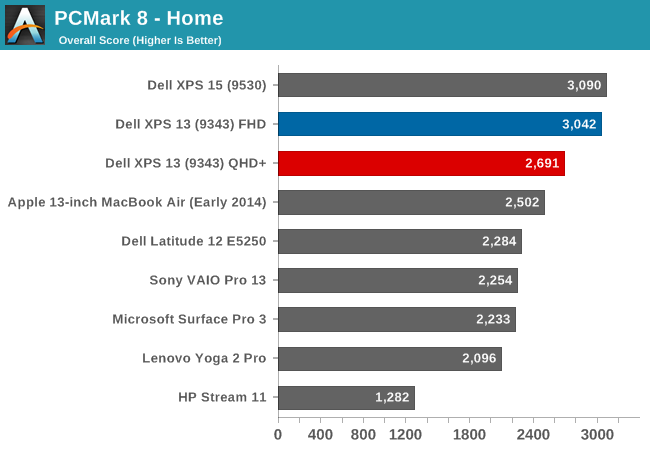
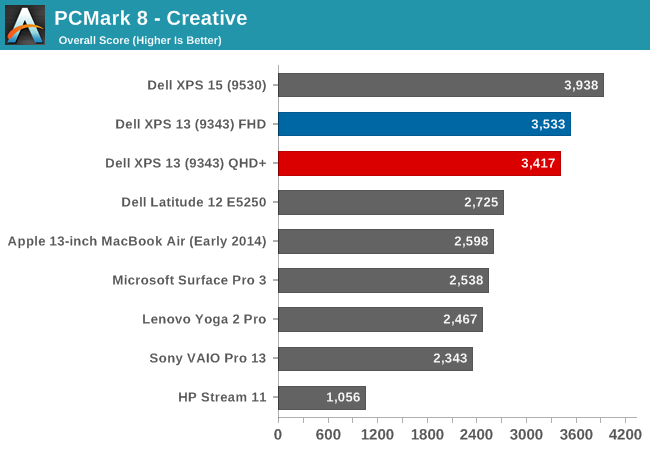
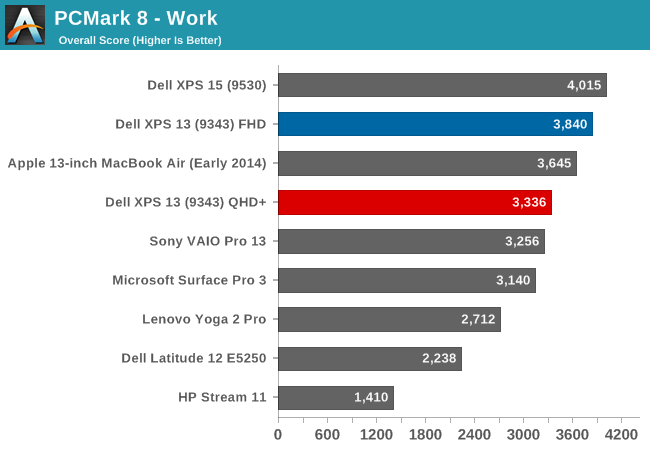
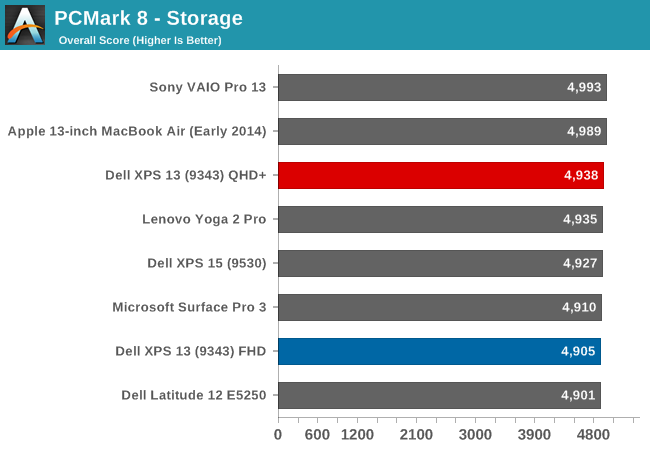
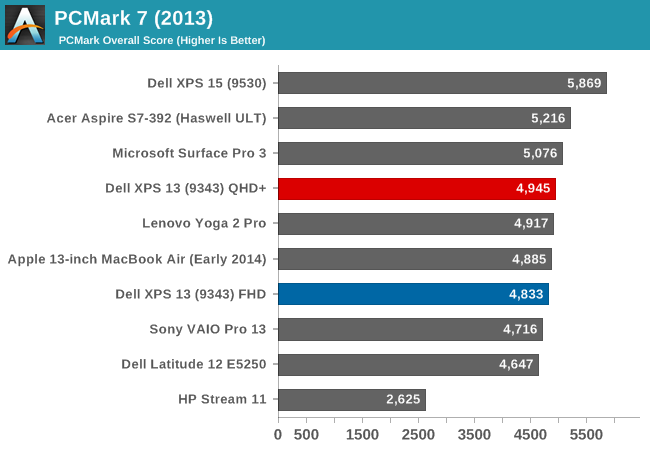
PCMark 8 from Futuremark runs through a variety of tests, and many of the test feature OpenCL support. The Home benchmark runs through what the typical home user would do: web browsing, gaming, and photo editing. Creative is for media and entertainment creation and is more demanding than the Home test. The Work suite tests basic office tasks. The higher resolution model has more work to do on these and scores a bit behind the 1080p model, but overall the new XPS 13 scores quite well on these types of workloads.
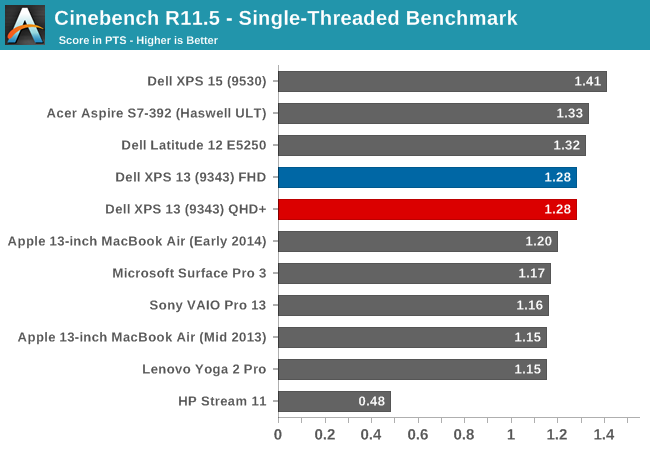

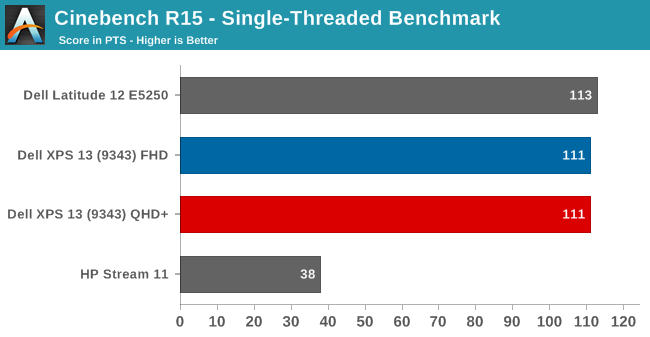
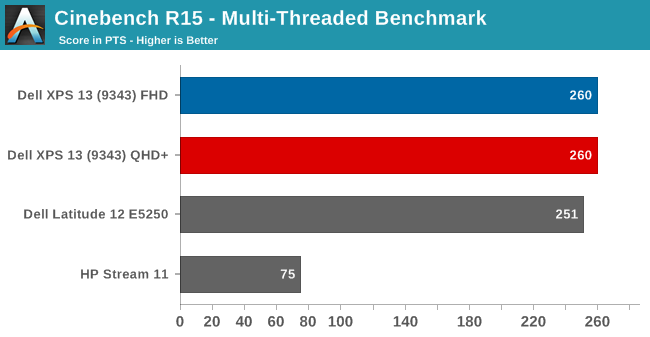
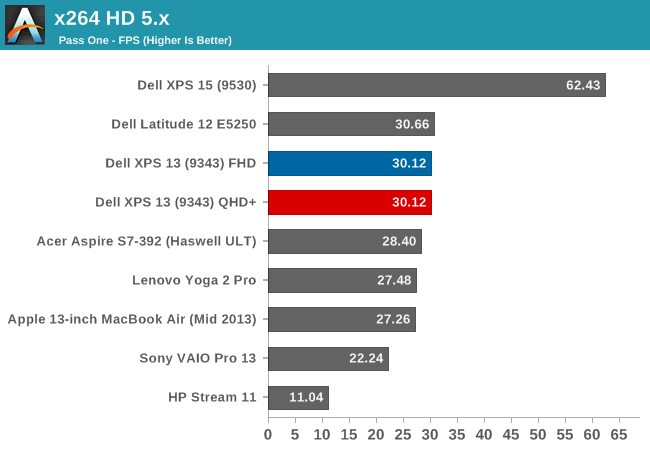
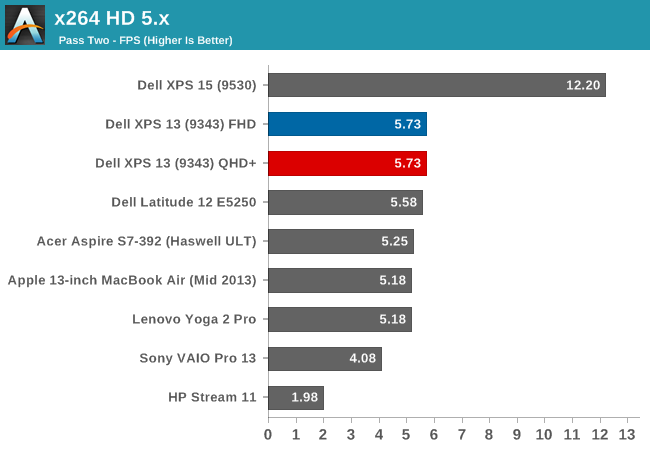
Cinebench tests the CPU's ability to render a scene. Broadwell-U does well here, and though the single core scores show that the i5-5200U is a bit slower than the Acer's i7, and especially the XPS 15 with it's higher TDP part, there is a nice bump up from the i5-4200U in the Lenovo Yoga 2 Pro. Multithreaded is where the new 14nm process can really shine. The lower power usage means that there is more headroom for the CPU to keep the clock speeds higher when all cores are active, and it shows a great result here compared to the Haswell-U series parts. x264 HD also shows favorable results for Broadwell, with the i5-5200U outperforming the old i7-4500U. The Dell XPS 15, with the full quad-core, eight-thread CPU, unsurprisingly outperforms all of the U series CPUs.
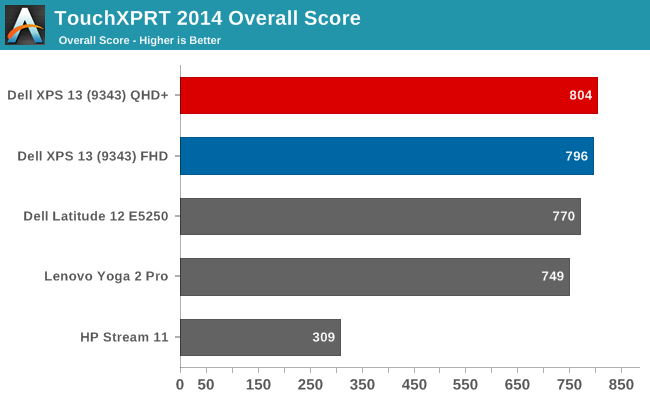
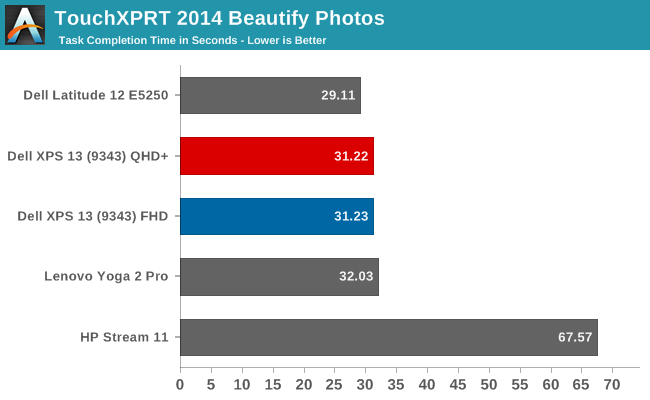
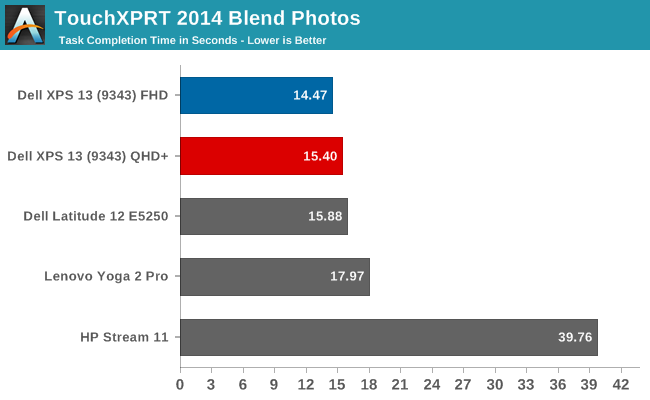
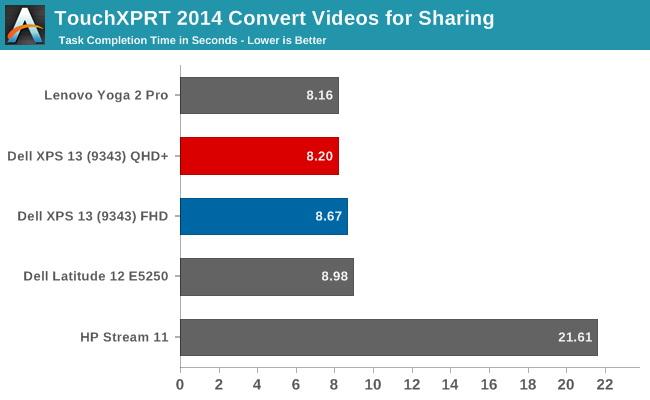
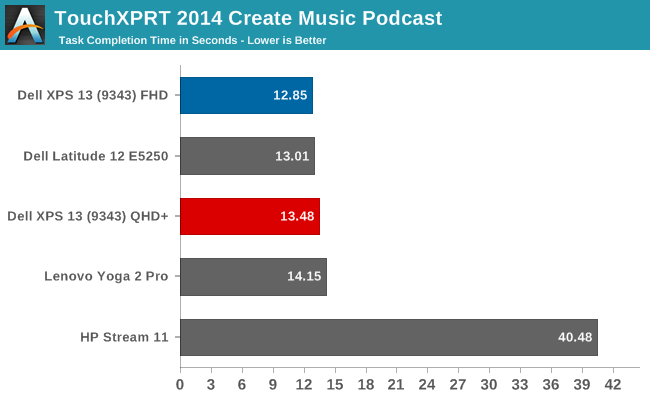

TouchXPRT 2014 is a WinRT app found in the Windows App Store that performs a series of common tasks for a typical home user, and calculates a score based on how quickly the tasks were performed. Here Broadwell seems to perform very similarly to Haswell, with the exception of the video conversion which was quite a bit slower. Update 2015-02-20: Intel has provided us with an updated graphics driver which solves the slow video conversion issue. I have re-run the tests and updated the graphs. If you would like to install this driver from Intel.com, you must first remove the existing one from Programs and Features or you will be blocked from installing, since the version that comes with the device is from Dell.
The Yoga 2 Pro has the Core i5-4200U, and the Dell XPS 13 is the Core i5-5200U, so it makes a good comparison for performance. Overall, the Broadwell based XPS 13 is generally slightly faster than the previous generation processors, but not by much for most single cpu tasks. Multithreaded scenarios show a nice gain in performance with Broadwell just from the ability to keep the clock speeds higher under heavily threaded loads.
As expected, the switch to 14nm did not bring a huge performance change for the CPU, and for that we may have to wait for Skylake, which is the next Tock from Intel (new processor architecture) coming later this year. The Dell XPS 15, with its higher wattage quad-core CPU, shows a clear lead as expected, and the Atom processor in the HP Stream 11 is sorely outclassed.
Interestingly, the FHD model was able to outperform the QHD+ model on a couple of the PCMark 8 tests. I’ve re-ran the benchmarks several times, and these results are consistent. The PCMark tests do include some gaming and other GPU loads which would be slower on the high DPI display.
WiFi
The review units we received both came with the Dell Wireless AC 1560 adapter, which is based on a Broadcom chipset. Originally I had connection issues on 5 GHz with the QHD+ model, but Dell shipped out a driver update which seems to have sorted that, so if you have purchased one of the early model XPS 13s, check Dell’s site for some updates.
Optionally, Dell will outfit the XPS 13 with the Intel Dual Band Wireless-AC 7265 adapter, or the spec sheet also lists the Wireless-N version of this Intel adapter. I have seen and used the AC 7265 on a couple of machines, such as the Dell Latitude 12 E5250, and it performed very well.
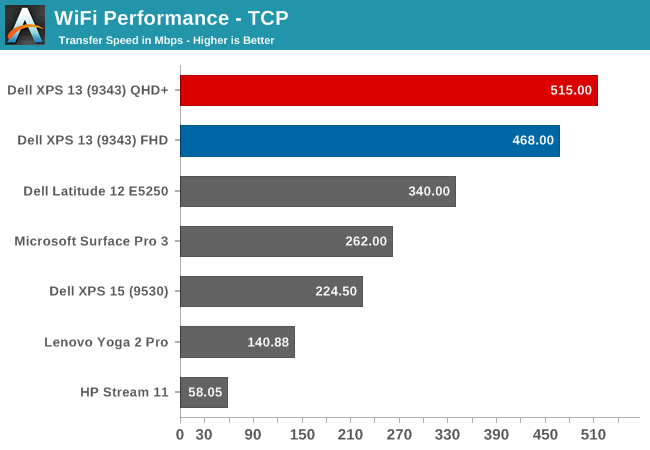
Wireless performance was very good, with the Broadcom chip pulling to the top of the chart. Once the initial connection issues were resolved with the driver update, I had no problems with the wireless connection on the XPS 13.










201 Comments
View All Comments
Brett Howse - Monday, March 23, 2015 - link
Someone else had asked me that, so I set the 3200x1800 display to 1600x900, just to see if part of the battery life loss was due to rendering. My battery life test for this setting was almost identical to the 3200x1800 resolution.So it does not improve battery life because the main power draw of the higher resolution display is the increased requirements of the backlight to drive the same brightness level through a much more dense TFT. At least that was my findings on the XPS 13.
growl - Monday, March 23, 2015 - link
Thanks very much, appreciate it! Torn on which one to buy, given that I am a frequent traveler, but also generally enjoy touch and have a pretty much unlimited budget.mazzy - Thursday, March 26, 2015 - link
Hi Brett, Any Update on Auto Dynamic LCD brightness ?Brett Howse - Saturday, March 28, 2015 - link
Nothing yet sorry.mazzy - Tuesday, April 7, 2015 - link
I think that it'll never be fixed. It's April.. over 3 months from the launch...It's a pity, a great quality screen but with a glaring defect... no calibration possible... :(
FranC - Wednesday, April 8, 2015 - link
I bought the 2015 Dell XPS 13 on the assumption that Dell would release a fix that would allow end users to calibrate the display. As mazzy said, it seems like Dell has no intention of fixing this, perhaps because it would reveal that battery life is highly dependent on Adaptive Brightness being enabled. Guess I'll wait to the last day to return it, and file this one away as being Duped-by-Dell.paul1508 - Monday, April 20, 2015 - link
Does the standard Dell Wireless 1560 support Intel Wireless Display (WiDi) or do I have to opt in the Intel AC 7260? Does that matter at all because the Dell Wireless 1560 might support Miracast?technoway - Monday, April 27, 2015 - link
The battery life for the system:i7-5500U / 8GB-RAM / 512GB-SSD / 3200x1800 infinity touch
is listed to be only about 7.5 hours.
The Apple 13-inch Macbook gets 10 hours or more.
But, Dell doesn't offer the 512 GB SSD, which I need for space, without also having the power-sucking HD+ screen. That stops me from buying the latest XPS-13.
Dell could make simple changes and make a machine I'd buy, but for some reason they don't do this.
The core i7 processor is a must, because it consumes less power than the core i5, and a 512 GB SSD is also a must to compete with Apple machines, but the HD+ screen wastes too much power. An HD screen is just fine on a 13-inch machine.
Until I can get a i7-5500U / 8GB-RAM / 512GB-SSD, with just the HD display (I don't care whether it's touch or not), I won't buy this. With the HD display, that system would have great battery life - I'd estimate at least 10 hours, and probably more like 11 or 12, maybe more. Dell ruins the machine by not offering the best options for battery life.
I do have an older first-generation XPS 13, and I like it, but with a meager 128 GB, 70 GB taken by the OS and restore partition, it's got too little storage.
If Dell makes the machine I want, I'll buy one tomorrow. If they don't make that by Christmas, I'll probably purchase the Apple 13 inch model. It has the good battery life for an Ultrabook.
Oh, and Dell's suggested solution for the poorer battery life is to carry around a plug-in battery pack for extra power. That competely defeats the purpose of having an Ultrabook!
vaga13ond - Saturday, June 11, 2016 - link
You're comparing apples to oranges there. Trying to compare the XPS vs a Macbook isn't really targeting the same user. Macbook's come with Core m3 or m5 (below i-series) processors not the i7 processor that you consider a "must." No touch screen, no QHD, worse on board graphics, DDR3, single port, yada yada yada... And no, the Macbook does NOT get 17.5+ hours on a battery charge doing anything besides idling. The XPS is a VERY different machine than the Apple Macbook...rgin - Monday, October 12, 2015 - link
Would the performance of this beauty be affected if we ran linux on it?